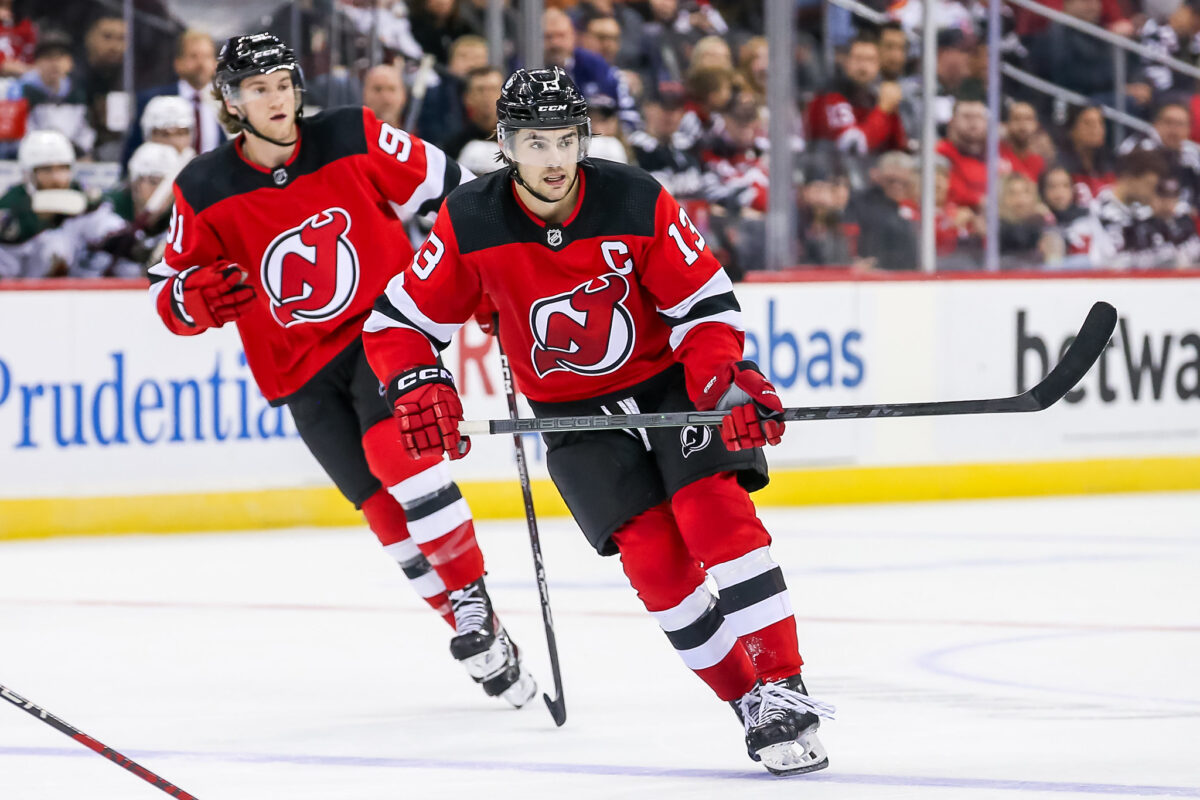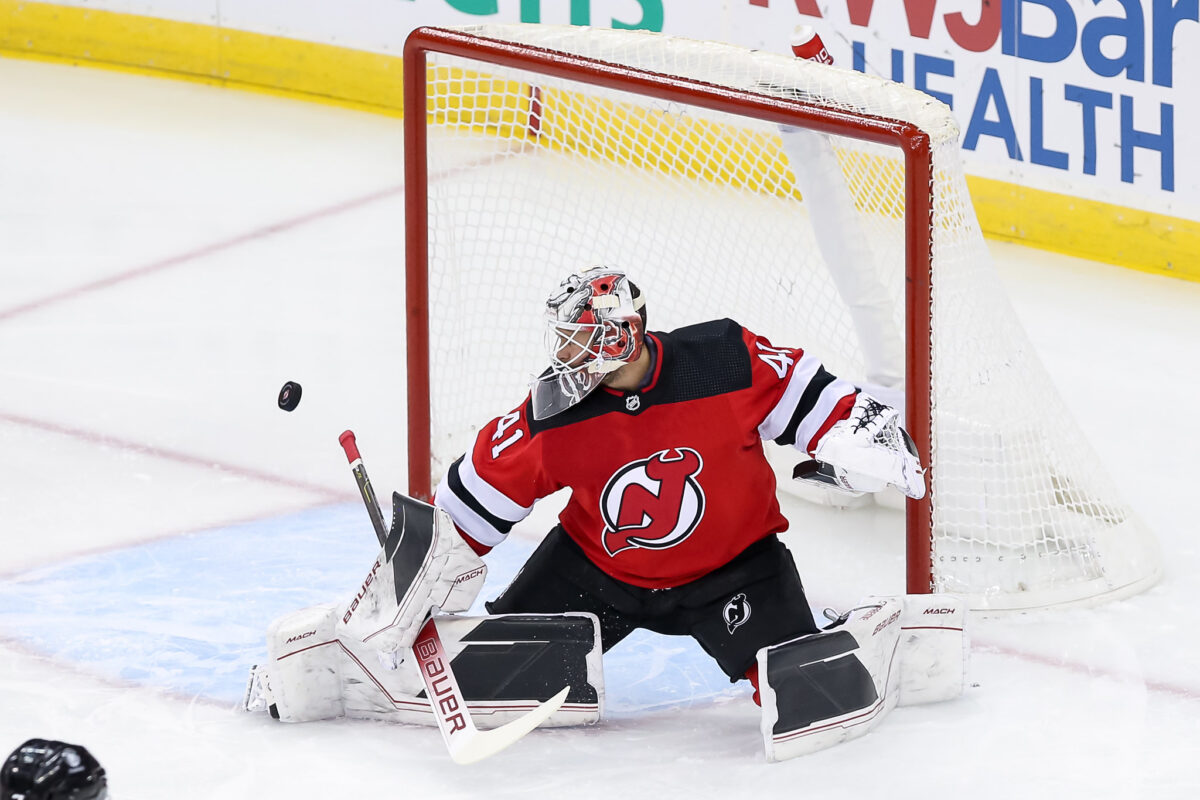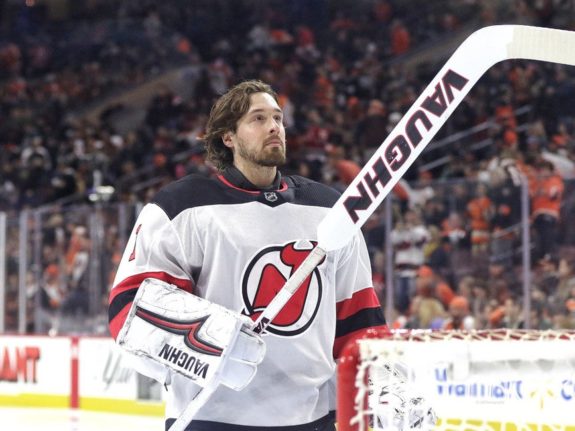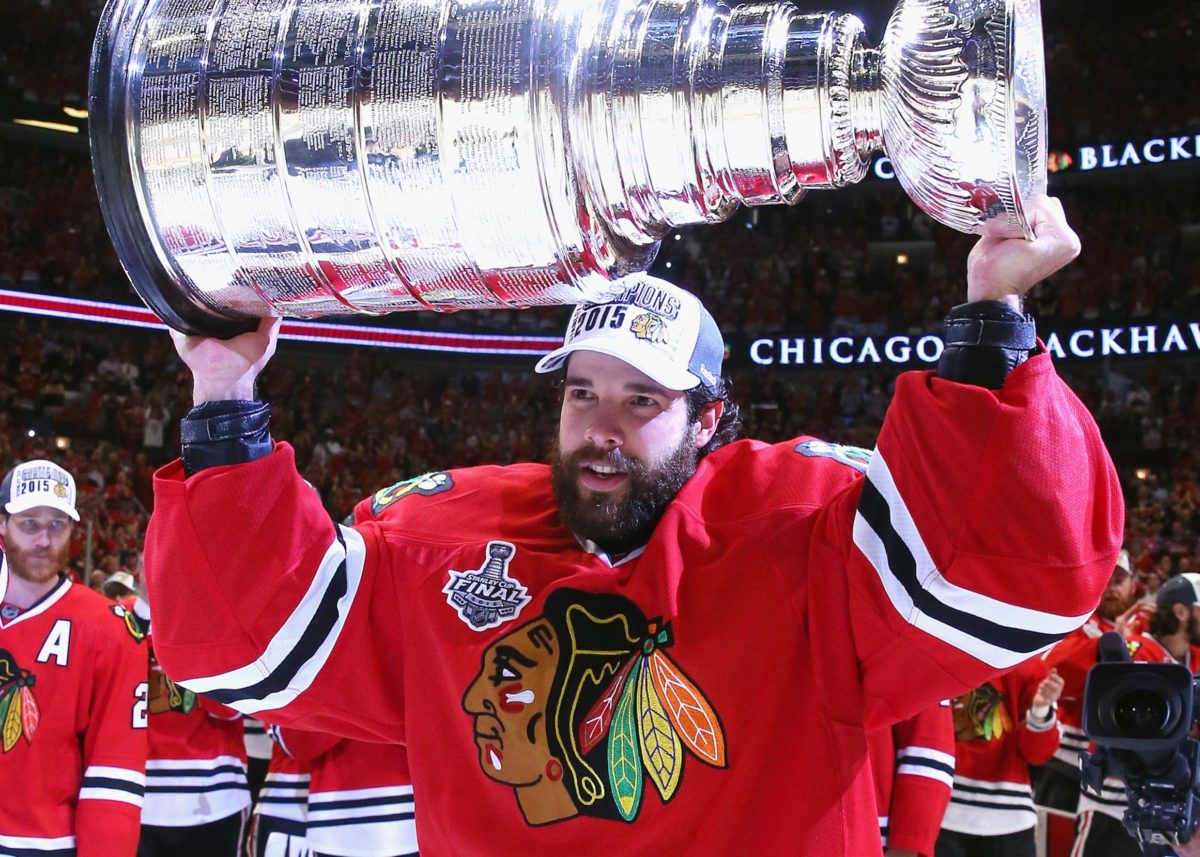In his time as the general manager of the New Jersey Devils, Tom Fitzgerald has pushed almost all of the correct buttons. He has drafted well, signed a core group of young players to long-term, team-friendly deals, done a tremendous job at pro scouting, finding players on other teams that fit the Devils’ style, and trading distressed assets to acquire the players, then securing them long term. He has also made calculated free-agent signings that have paid off without saddling the team with dead-cap money requiring buyouts or preventing other necessary acquisitions. He hired the right head coach on his first try, bringing in a grizzled veteran who has found a way to relate to his younger players and develop the talent into all-star-level talent.
Related: Devils’ December 2023 Preview
Fitzgerald spent this summer assembling a team with the deepest and most talented forward group in the NHL, backstopped by a defense corps that included two of the top ten prospects in hockey, one of the best offensive defensemen in the game, and two shutdown defensive-minded defensemen. The team seemed poised to build on their success last season and was ready to acknowledge that their window of contention had now cracked open. Reports circulated all offseason that Fitzgerald was in discussions with several NHL clubs regarding obtaining a bonafide starting goaltender; however, none of those talks bore fruit. Now, with the team struggling to find consistent play in the net, Fitzgerald faces a key point in his tenure that he must successfully navigate or risk giving away a full season of his young core’s window of contention.
Diagnosing the Problem
The issues facing the team are not simply fixed by making one move, or are they? The Devils have suffered from a dire combination of poor finishing, mistakes in defensive zone coverage, and the failure to get timely and consistent saves from the goaltenders. Last season, the Devils were a dominant 5-on-5 team and rode that success to the second round of the Stanley Cup Playoffs.
This year, they have had trouble winning at even strength, and while they possess the top power play in the league, they have been unable to overcome a -11 goal differential at 5-on-5. The most telling stat is that if they simply finished and defended in line with their expected goals for and against, they would be at +8. Instead, they finish and defend well below expected and are a net -20 in expected goal differential at 5-on-5. (per MoneyPuck)

The rash of injuries that have mostly impacted the forwards have now crept into the defense corps and have contributed to the team’s disconnect. Never was there a plan to play Curtis Lazar or Mike McLeod on the first line, and while it was great to see the two gritty forwards step up amidst the extended stretch of games without the likes of Nico Hischier, Jack Hughes, Timo Meier, and others, the Devils have not gotten much of an opportunity to play as the team Fitzgerald envisioned when he put the pieces together this summer.
Hischier has only played in half the games so far this season, and with him in the lineup, the team is 8-3-1; without him, the team is 4-7-0. Is it that simple? Is the team okay as long as Hischier and Hughes are in the lineup, or is there a bigger underlying issue that Fitzgerald has to address? Since Hischier’s return, the team is third in the NHL in expected goal percentage and points percentage.
The concerning thing for the Devils is that they must outscore opponents every night, and no lead seems safe. In Vancouver on Tuesday evening, in their first game of a four-game western road trip, the Devils came out flying, scoring four goals in the first period and ultimately building a 5-2 lead on the back of dominant play at 5-on-5. They were playing fast, killing plays early in the defensive zone, breaking out the puck seamlessly, and Vitek Vanecek made timely stops.
But it all came crashing down in the third period when the three-goal lead evaporated, and the game was tied with just under four minutes to go. Fortunately, the team tapped into its deep reservoir of resiliency and, for the second time in a week, found a way to win the game in the final minute. And while the team had to be happy with the result, needing to find late magic again after holding a big lead has to be alarming.

Vanecek’s stats in the Vancouver game were better than his prior work. He posted positive goals saved expected for the game, but his penchant for allowing rebound opportunities is a concern. He let in one goal above expected on rebounds and gave up six rebound shots above expected. Had it not been for heroic play from some of his defensemen and Hischier on several rallies, he easily could have given up more rebound goals.
Akira Schmid has been similarly inconsistent. He has demonstrated a unique ability to be an elite goaltender when used as a mid-game replacement, posting a .950 save percentage (SV%) in his career in that role. But he has struggled to take control of the net for any extended period.
Ruff gave Schmid a rare opportunity to play both ends of a back-to-back game as a reward for defeating the Philadelphia Flyers. Schmid repaid his coach’s confidence by allowing five goals to the San Jose Sharks on 17 total shots. The Sharks have certainly played better of late, but it was a missed opportunity for Schmid, who had the chance to put a stranglehold on the starter’s crease. To be fair, his defense let him down several times, but he gave up nearly four goals above expectations on only 17 shots.
With the return to the lineup of Hischier, a healthy Erik Haula, Lazar, and McLeod, the Devils should be better defensively, as their system is predicated on back-checking from the centers and hard forechecking. They will have to live with rookie errors from Simon Nemec and Luke Hughes while they try to weather the storm of Dougie Hamilton’s potentially season-ending injury. Now that Brendan Smith has returned to the lineup, they will have seven viable defensemen for the first time all year, allowing Ruff to mix and match depending on performance and opponents. With the ability to take Kevin Bahl, Jonas Siegenthaler, or Nemec off the ice for a game here or there so they can correct mistakes, the defense can only improve.
With both the offense and defense headed in the right direction, the issue that has not improved is in the net. The goalies have combined for the second-worst save percentage in the NHL at .871. Of the 44 goalies who have played at least ten games this season, Schmid ranks 33rd, and Vanecek ranks 43rd in goals saved above expected. It is difficult to imagine that a team only two points out of a wild-card spot and only four points out of second place in the Metropolitan Division would not be firmly ensconced in playoff position had they received even league-average goaltending. The tandem has combined to allow 11.6 goals above expected in just 23 games. Last season, in 70 games, the tandem combined to save more than 13 goals above expected, with Schmid stopping eight above expected in just 18 games.
Now What for the Devils?
Since Hischier returned from injury, the team has started to play like the team Fitzgerald envisioned. In those five games, they led the league in points percentage and in shooting percentage at 5-on-5, nearly doubling what they were shooting without Hischier. They have limited teams to 20 shots per game at 5-on-5, outshooting, out-chancing, and getting more high-danger chances than their opponents. The one outlying statistic is that they are the worst in the league in making high-danger saves with an alarming 67.65 SV%, which results in them only having one more high-danger goal than their opponents despite them having 18 more chances.
Fitzgerald has three distinct options: stick with Vanececk and Schmid, hoping they will regain something similar to their form from last season, add from within by promoting a goalie from the American Hockey League, or seek help outside the organization. The general manager himself has consistently said that it takes 20 to 25 games to evaluate your team and determine if you have to address any deficiencies. At the 23-game mark, the need for better goaltending is apparent.
The choice of running it back and trying to recapture last season’s success was the decision Devils management made this summer, foregoing the opportunity to make a splashy trade for a top-tier goaltender. It hasn’t worked. Schmid is still young and has shown he does not get flustered and can rise to big moments. Arguably, he plays better under pressure than he does when his work is sporadic or the game has less meaning. They should invest in Schmid and keep him in the fold; he has shown signs of breaking out and demonstrated he can be a valuable playoff performer.
On the other hand, Vanecek has not. In his now fourth full season in the NHL, he has proven to be, at best, a league-average goaltender who is athletic enough to make difficult saves but not positionally sound enough to consistently make critical saves. He has also been dreadful in his opportunities in the postseason, both with the Washington Capitals and Devils.

In the offseason, the Devils acquired two NHL veterans, Keith Kinkaid and Erik Kallgren. Each has played in the AHL this season, but neither has had outstanding results. In nine games, Kinkaid is 2-6-1 with a .870 SV%, while Kallgren is 1-5-2 with a .851 SV%. There is no telling that either could not catch lightning in a bottle and go on a few-week streak in the NHL and carry the Devils, but the likelihood of either being a long-term, season-improving answer is remote. The best goalie thus far in the organization at the AHL level has been Isaac Poulter, who has a .915 SV% but has not shown a sustained ability to be successful in the NHL and warrant a call-up; he’s also just on an AHL deal.
The final option is to go outside the organization. Unfortunately, this is both the best and most difficult option for the long-term success of the franchise. There are no perfect matches or easy moves. There is a clear shortage of quality goaltending in the league. As offenses have improved, the average SV% continues to drop and may soon dip below .900. This makes the bonafide, star goaltenders extremely valuable and expensive. Much like relief pitchers in baseball, there is a dearth of consistently excellent goalies, which leaves GMs with the choice of trying to find a different hot one year after year or paying a premium for a player regularly in the top five or ten. There are plenty of ways Fitzgerald can go as there are still options available to him, but he will need to get creative.
Why Now?
This decision for Fitzgerald is crucial and will go a long way to determining his legacy in New Jersey. He has constructed a young, exciting, talented team, sprinkled with veterans and role players, that has already won a playoff series and is poised to make noise for the next decade if he can find a goaltender to build around. Fans often buy into the fallacy that you don’t need an excellent goaltender to win the Stanley Cup and that you only need a goaltender to get hot.
While the second part of that is certainly true, the chances of a world-class goalie getting hot are far more likely than that of a league-average journeyman. The dynasties of the last decade were built on solid foundations down the middle of the ice from center all the way to the goaltender. Teams have certainly ridden the likes of Darcy Keumper to a Cup, but not multiple. Neither Tampa Bay nor Chicago win multiple Cups without Andrei Vasilevskiy or Corey Crawford.

The inflection point for Fitzgerald is simple. Is he willing to risk a year of his core’s prime in the playoffs on league average or below goaltending with the hope that one of the goalies can get hot at the right time? That has been the most important question he has grappled with since the Devils skated off the ice in Carolina after dropping Game 5 in overtime to close out the second round. While the team has shown it can score in bunches, and with the development of the power play as a real weapon harnessing their massive talent, offense alone cannot win championships.
Fitzgerald’s goal has to be a return to the glory days of the Devils’ dynasty, where they won three Cups in eight years on the back of a Hall of Fame goaltender. Fitzgerald has done the heavy lifting, taking a team marooned at the bottom of the standings, playing in front of an empty arena, revitalizing the franchise by not missing with three top-four picks, getting the best of multiple trades, and signing free agents who perfectly fit their needs.
There is one piece remaining, and judging by Fitzgerald’s track record, he likely has a plan and certainly realizes that he can no longer continue with the status quo. Who he chooses to acquire and when he decides to make that move will go a long way to cementing his legacy and potentially bringing the Cup back to New Jersey.
